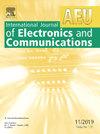Analysis and design of concurrent class-F2 power amplifier based on power-series technique
IF 3
3区 计算机科学
Q2 ENGINEERING, ELECTRICAL & ELECTRONIC
Aeu-International Journal of Electronics and Communications
Pub Date : 2025-02-21
DOI:10.1016/j.aeue.2025.155722
引用次数: 0
Abstract
Though the design procedures of dual-band power amplifiers (PAs) have been thoroughly studied in previous works, these studies have seldom delved into analyze the dual-band PA when it is driven by a concurrent dual-band signal. This paper presents the analysis and design of broadband class-F PA operating in concurrent mode. The class-F PA driven by a concurrent dual-band signal is analyzed using power series technique. It is illustrated that, compared to a concurrent class-B PA, the concurrent class-F PA exhibits an increased output power of 4.8 dB. Furthermore, when excited by a concurrent two-tone signal, the output power decrease of the class-F PA is merely 0.8 dB, as opposed to single-tone signal excitation. A broadband 1.8–2.2 GHz class-F PA supporting concurrent operation is designed and measured in this work. When excited by a single-tone signal, the broadband PA achieves a maximum output power of 41.1–42.4 dBm with a drain efficiency (DE) of 61.8%–67.3%. On the other hand, under the excitation of a concurrent two-tone signal centered at 2.0 GHz, the fabricated PA achieves an output power of 40.0–40.6 dBm with a DE of 60.0%–64.0% across a tone-spacing of 0–400 MHz.
基于功率串联技术的并行f2类功率放大器的分析与设计
虽然以往的研究已经对双频功率放大器的设计过程进行了深入的研究,但这些研究很少深入分析双频信号驱动下的双频功率放大器。本文介绍了一种工作在并发模式下的宽带f2pa的分析与设计。利用幂级数技术对双频信号驱动的f2类PA进行了分析。结果表明,与并行的b类放大器相比,并行的f2类放大器的输出功率增加了4.8 dB。此外,当同时受到双音信号激励时,与单音信号激励相比,f2类PA的输出功率下降仅为0.8 dB。设计并测试了一种支持并发操作的1.8-2.2 GHz宽带f2级PA。在单音信号激励下,宽带放大器的最大输出功率为41.1 ~ 42.4 dBm,漏极效率(DE)为61.8% ~ 67.3%。另一方面,在以2.0 GHz为中心的并发双音信号激励下,该放大器在0-400 MHz的频距范围内的输出功率为40.0-40.6 dBm, DE为60.0%-64.0%。
本文章由计算机程序翻译,如有差异,请以英文原文为准。
求助全文
约1分钟内获得全文
求助全文
来源期刊
CiteScore
6.90
自引率
18.80%
发文量
292
审稿时长
4.9 months
期刊介绍:
AEÜ is an international scientific journal which publishes both original works and invited tutorials. The journal''s scope covers all aspects of theory and design of circuits, systems and devices for electronics, signal processing, and communication, including:
signal and system theory, digital signal processing
network theory and circuit design
information theory, communication theory and techniques, modulation, source and channel coding
switching theory and techniques, communication protocols
optical communications
microwave theory and techniques, radar, sonar
antennas, wave propagation
AEÜ publishes full papers and letters with very short turn around time but a high standard review process. Review cycles are typically finished within twelve weeks by application of modern electronic communication facilities.

 求助内容:
求助内容: 应助结果提醒方式:
应助结果提醒方式:


